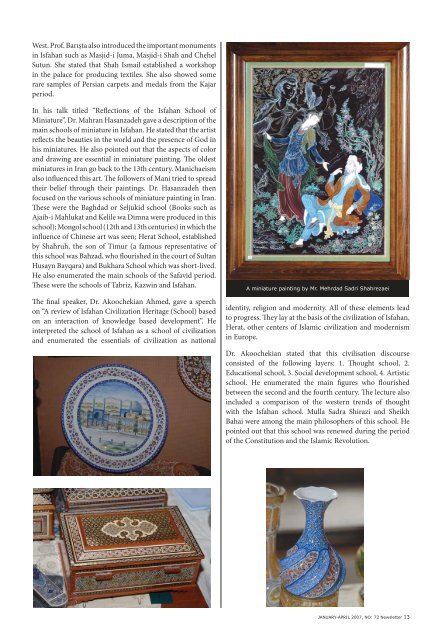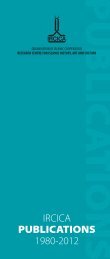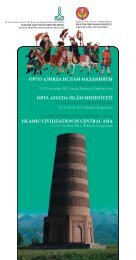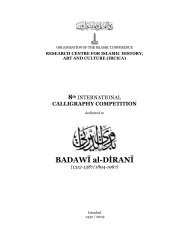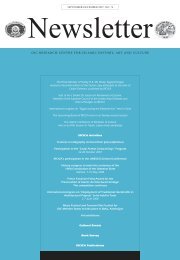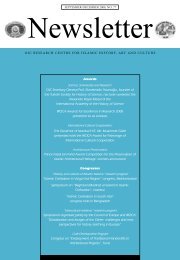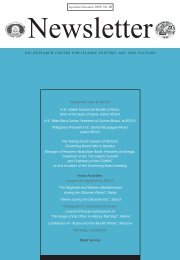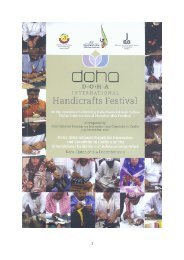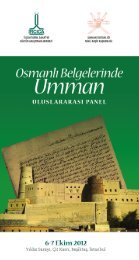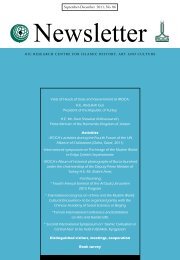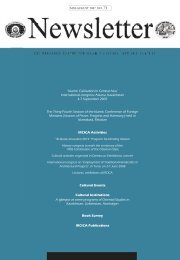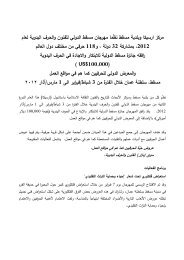Next, the Consul General of the Islamic Republic of IranH.E. Mr. Sayid Kamal Yasini took the floor. He underlinedthe historical and cultural importance of the city of Isfahan.He stated that further research is needed on aspects such asthe historical periods (both pre-Islamic and Islamic eras)which the city underwent, the views of Orientalists and otherwriters about different aspects of Isfahan such as industry andcommerce, tourism, geographical location, historical legacy,traditions and the artists who flourished there. The ConsulGeneral suggested that Istanbul and Isfahan be declaredsister cities and underlined various common characteristicsof both cities.The next speaker was Prof. Dr. Mehmet Kanar from theUniversity of Istanbul, Faculty of Letters, Department ofEastern Languages and Literature. He presented a paper on“The travels of Sadık Hidayet in Iran”. He pointed out that asan author with multiple interests, Sadık Hidayet introducedmodern Persian literature to Turkey in the 20th century. He iswell-known for his contribution to modern Persian literature.He is also known for his stories and plays. The famous Turkishpoet late Behçet Necatigil translated his novel titled “BlindOwl”. Prof. Mehmet Kanar translated his book of travels.In this book, published in 1932, he describes the buildings,miniatures and paintings that he has seen as a historian of art.He also analyzes the social and anthropological structure inIsfahan. He then moves from Tehran to the city of Qom anddescribes the Chehel Sutun. Prof. Kanar’s Turkish translationof the travelogue was published by Yapı Kredi Publicationsunder the name of Hidayetname.Dr. Hasan Bolkhari, member of the Iranian Academy of Art,talked about the Isfahan school of art, focusing particularlyon “The philosophy of architecture: reconstitution of theuniverse based on sacred geometry”. He stated that Isfahanwas the capital city of the Safavid Dynasty for 150 years. Itwas not only a city, but at the same time a school of art andphilosophy.enumerated some events and activities that had beenorganized by <strong>IRCICA</strong> jointly with the Ministries and thecultural institutions of the Islamic Republic of Iran and thestudies of the Centre relating to Iran. Among the former,the largest event was the International Congress on IslamicArts and Crafts which was held in Isfahan in October 2002.The papers in Persian were printed and those in English andArabic are under preparation for publication. Of the latter, onevolume of the World Bibliography of Translations of the HolyQur’an in Manuscript Form will be devoted to translations inPersian language. The Director General recalled that Isfahanwas declared as the City of Culture last year. He thankedthe Consulate General, Directorate of Culture and Ministryof Foreign Affairs of the Islamic Republic of Iran for theirvaluable cooperative efforts.Mulla Sadra Shirazi was the most important representativeof this school of philosophy. His philosophy synthesizesthe views of Ibn Sina, Farabi and Mevlana Jalaladdin Rumi.Mir Damad and Sheikh Bahai were among the famousrepresentatives of this school. Dr. Bolkhari pointed out thatthe architecture of Isfahan combines modern and traditionalstructures. The second part of Dr. Bolkhari’s talk focused onthe arts of decoration and geometric design in the architectureof Isfahan. He pointed out that sacred architecture symbolizesthe universe in Persian, Indian and Greek philosophy.The next speaker, Prof. Örcün Barışta from the Universityof Marmara, spoke on “The gifts of Isfahan to the worldof art”. She made a chronological presentation of differentbranches of Islamic art in Iran particularly during the Safavidperiod accompanied by the slides of various objects kept inmuseums. Among them were weapons, metalwork, textiles,embroideries, woodwork, glasswork, laquerwork, etc. Shestated that although the period of Shah Tahmasp was ratherstagnant, Shah Abbas was more open both to the East and the12 <strong>Newsletter</strong> JANUARY-APRIL 2007, NO: <strong>72</strong>
West. Prof. Barışta also introduced the important monumentsin Isfahan such as Masjid-i Juma, Masjid-i Shah and ChehelSutun. She stated that Shah Ismail established a workshopin the palace for producing textiles. She also showed somerare samples of Persian carpets and medals from the Kajarperiod.In his talk titled “Reflections of the Isfahan School ofMiniature”, Dr. Mahran Hasanzadeh gave a description of themain schools of miniature in Isfahan. He stated that the artistreflects the beauties in the world and the presence of God inhis miniatures. He also pointed out that the aspects of colorand drawing are essential in miniature painting. The oldestminiatures in Iran go back to the 13th century. Manichaeismalso influenced this art. The followers of Mani tried to spreadtheir belief through their paintings. Dr. Hasanzadeh thenfocused on the various schools of miniature painting in Iran.These were the Baghdad or Seljukid school (Books such asAjaib-i Mahlukat and Kelile wa Dimna were produced in thisschool); Mongol school (12th and 13th centuries) in which theinfluence of Chinese art was seen; Herat School, establishedby Shahruh, the son of Timur (a famous representative ofthis school was Bahzad, who flourished in the court of SultanHusayn Bayqara) and Bukhara School which was short-lived.He also enumerated the main schools of the Safavid period.These were the schools of Tabriz, Kazwin and Isfahan.The final speaker, Dr. Akoochekian Ahmed, gave a speechon “A review of Isfahan Civilization Heritage (School) basedon an interaction of knowledge based development”. Heinterpreted the school of Isfahan as a school of civilizationand enumerated the essentials of civilization as nationalA miniature painting by Mr. Mehrdad Sadri Shahrezaeiidentity, religion and modernity. All of these elements leadto progress. They lay at the basis of the civilization of Isfahan,Herat, other centers of Islamic civilization and modernismin Europe.Dr. Akoochekian stated that this civilisation discourseconsisted of the following layers: 1. Thought school, 2.Educational school, 3. Social development school, 4. Artisticschool. He enumerated the main figures who flourishedbetween the second and the fourth century. The lecture alsoincluded a comparison of the western trends of thoughtwith the Isfahan school. Mulla Sadra Shirazi and SheikhBahai were among the main philosophers of this school. Hepointed out that this school was renewed during the periodof the Constitution and the Islamic Revolution.JANUARY-APRIL 2007, NO: <strong>72</strong> <strong>Newsletter</strong> 13


